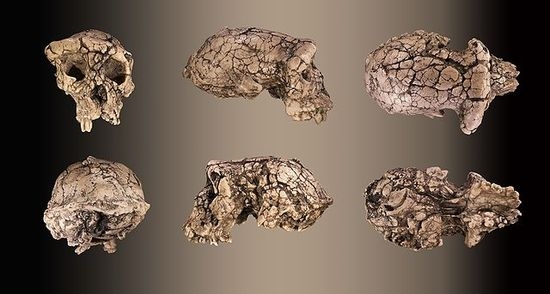Sahelanthropus tchadensis: Ten Years After the Disocvery
A decade ago, scientists unearthed what may be the oldest hominid ever found
The seven-million-year-old Sahelanthropus tchadensis skull, known as Toumai, viewed from different sides. Image: Didier Descouens/Wikicommons
Ten years ago, an international group of anthropologists made a bold claim: They had unearthed the earliest hominid ever found, in the Sahel region of Chad. They named their discovery Sahelanthropus tchadensis. Today, many anthropologists agree that the seven-million-year-old Sahelanthropus was an early hominid while others suggest it was nothing more than an ancient ape.
The team, led by Michel Brunet, now at the Collège de France, originally found six hominid specimens in Djurab Desert of northern Chad in 2001. The discovery included a nearly complete, yet distorted, skull (nicknamed Toumaï, meaning “hope of life” in the local Goran language). Although very primitive, the skull, jaw and teeth displayed some hominid-like traits. For instance, the species had a relatively flat face instead of a protruding muzzle like a chimp. And the tip of the canine tooth was worn down, as it is in humans. This suggested Sahelanthropus lacked a “honing” complex in which the back side of the upper canine sharpens itself against the lower first premolar (what your dentist might call a bicuspid). This appears to be a trait that hominids lost after they split from the chimpanzee lineage. In addition, Sahelanthropus’ foramen magnum—the hole at the base of the skull that the spinal cord runs through—was situated further forward than a chimp’s, implying Sahelanthropus had an erect posture and therefore walked upright on two legs. In 2005, the team announced additional jaw and teeth discoveries from Djurab, as well as a virtual reconstruction of the skull that corrected the distortion. These new pieces of evidence supported the original find, the researchers said.
Based on the type and ages of other animal fossils found near Sahelanthropus—including freshwater fish, crocodiles, rodents and monkeys—the researchers concluded the species probably lived in a wooded environment near a lake, perhaps even in a swampy locale, six million to seven million years ago. Assuming the species was indeed a hominid, the time period implies the hominid-chimpanzee split must have occurred even earlier, contrary to some genetic studies that indicate a more recent split some five million years ago. And finding the hominid in Chad means early hominids lived beyond East Africa and were more spread out than paleoanthropologists had suspected.
But Sahelanthropus‘ hominid status is not universally accepted. In 2006, one group of researchers, including Milford Wolpoff of the University of Michigan and John Hawks of the University of Wisconsin, considered the structure and function of the reconstructed Sahelanthropus skull. Although the placement of the foramen magnum appeared similar to humans’, other aspects of the skull would have prevented the species from keeping its head upright—and therefore it couldn’t have been a bipedal walker, the team concluded. Thus, they suggested, Sahelanthropus was not a hominid, just some kind of ape. They further noted that some of the dental similarities Sahelanthropus shared with hominids could be cases of parallel evolution, when closely related species independently evolve similar traits due to shared evolutionary pressures.
Since 2006, the study of Sahelanthropus hasn’t advanced all that much. No additional fossils have been discovered—or at least, none of have been publicly announced. In 2009, Hawks blogged about the possibility of a Sahelanthropus femur. One of the researchers involved in the discovery of the species published a paper alluding to a thigh bone and even published a picture allegedly showing the original cache of fossils that included a femur.
As far as I know, a formal analysis of the bone has never been published. If there is a Sahelanthropus, studying it might help confirm whether the species walked upright—and whether it deserves to be included in the hominid family. Sometimes it takes scientists a long time to fully analyze a fossil find. It took the team that found Ardi and other Ardipithecus fossils about 15 years to publish full studies on that early hominid. So maybe in another five years Brunet and his team will have another announcement to make.
/https://tf-cmsv2-smithsonianmag-media.s3.amazonaws.com/accounts/headshot/science-erin-wyman-240.jpg)


/https://tf-cmsv2-smithsonianmag-media.s3.amazonaws.com/accounts/headshot/science-erin-wyman-240.jpg)